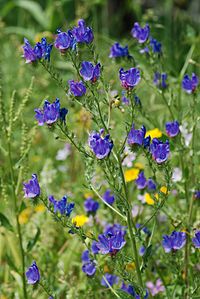
Photo from wikipedia
BACKGROUND Echium plantagineum a native of Europe and Africa, is a noxious invasive weed in Australia forming monocultural stands in pastures and rangelands. It produces a complex mixture of bioactive… Click to show full abstract
BACKGROUND Echium plantagineum a native of Europe and Africa, is a noxious invasive weed in Australia forming monocultural stands in pastures and rangelands. It produces a complex mixture of bioactive secondary metabolites including toxic pyrrolizidine alkaloids (PAs) that protect the plant from insect and livestock herbivory and naphthoquinones (NQs) that suppress competition from weeds, insects and pathogens, and also influence invasion success. However, the extent to which allelochemical production is impacted by environmental factors, thereby influencing plant defense against pests, remains unclear. RESULTS Following plant stress induced by drought, herbivory and high temperature, extracts of E. plantagineum shoots and roots were subjected to metabolic profiling by UPLC-MS-DAD- QToF mass spectrometry. Abundance of NQs, especially deoxyshikonin, shikonin and dimethylacrylshikonin, rapidly increased in roots exposed to elevated temperatures. Water withholding initially increased NQ abundance, but prolonged drought resulted in reduced total PAs and NQs. Intraspecific competition elevated the production of NQs, whereas simulated herbivory had no initial effect on NQs. Following herbivory, the abundance of the PA 3'-O-acetylechimidine-N-oxide in seedling shoots was increased. CONCLUSIONS Differential accumulation of defense metabolites by E. plantagineum following exposure to various stressors suggested stress-dependent biosynthetic regulation, particularly with respect to NQ production which was rapidly induced following drought, intraspecific competition and high temperature treatment, thereby positively impacting resistance or defense against herbivores, weeds and pathogens. We propose that trade-offs between above- and below-ground metabolism in E. plantagineum may facilitate allelochemical production in response to stress, rendering plants with an enhanced ability to defend against other neighboring plants, insects and microbes, with allelochemical production further facilitated by catabolic recycling following lengthier exposure to stress. This article is protected by copyright. All rights reserved.
Journal Title: Pest management science
Year Published: 2019
Link to full text (if available)
Share on Social Media: Sign Up to like & get
recommendations!